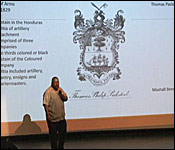3 weeks ago, we took you to the launch of the fully standardized Belize National Flag. The idea is to - once and for all - settle the colours and all the design details of the flag - so that all these flags with yellow men can come out of circulation.
But just what do we know about how and why the flag has evolved to what it is today? Well, NICH has been digging into the historical archives of Belize, the Caribbean, and the UK to track how exactly it has changed over the last 200 years. Nigel Encalada, the Director of the Institute of Social and Cultural Research, hosted a public lecture on the flag last night at the Bliss Center for the Performing Arts.
As you're aware, Belize's flag is unique because one of very few with human figures on it. But interestingly, the early models indicate that those 2 human figures were actually black men. So, why would Belize, a British settlement in 1800 - which was run by white slave owners - choose this coat of arms to identify itself?
Well, Encalada told the gathering that his research indicates that the earliest mention of it was on November 2nd, 1819. That's where we pick up the conversation on the history of the flag. Here's how Encalada explained it:
Nigel Encalada - Director, ISCR
 "At the bottom, you see that Marshall Bennett makes a motion, and the meeting is being presided over by Mr. Meighan. These are very wealthy men, by the way. These are the wealthiest settlers in Belize. You're looking at a population of maybe close to 4,000. And so, Marshall Bennett makes a motion, whereas it is necessary, in all well-regulated governments that a seal of arms should be had for the purpose of giving authority and credence to public acts and documents; and whereas this settlement stands in great need of the same. So that motion is put, and it is seconded by Thomas Paslow, and here you have a request for a seal of arms. Fast-forward a couple of years, if we move to the next slide, and we're at March 15th, 1821. And the minutes recorded here that the seal has been received, has been lodged and received."
"At the bottom, you see that Marshall Bennett makes a motion, and the meeting is being presided over by Mr. Meighan. These are very wealthy men, by the way. These are the wealthiest settlers in Belize. You're looking at a population of maybe close to 4,000. And so, Marshall Bennett makes a motion, whereas it is necessary, in all well-regulated governments that a seal of arms should be had for the purpose of giving authority and credence to public acts and documents; and whereas this settlement stands in great need of the same. So that motion is put, and it is seconded by Thomas Paslow, and here you have a request for a seal of arms. Fast-forward a couple of years, if we move to the next slide, and we're at March 15th, 1821. And the minutes recorded here that the seal has been received, has been lodged and received."
"So, the question that came to mind was how in a colonial slave society do you end up with 2 black men on the Coat of Arms?"
"What you see here, on the left, is a recent reproduction of the armorial ensigns of the 4th West India Regiment. And if you look to the right, you'll see the seal of the settlement. You'll see the resemblance that is starting to emerge."
"We asked the question, well who's responsible for this? Who has this idea of putting 2 black men on the seal of the settlement? And we've narrowed it down to 3 people, Thomas Pickstock the Third, Thomas Paslow, and Marshall Bennett. Now, what is curious about these 3 individuals is that they are white individuals. That's obvious at the time, but they're very powerful. Paslow and Bennett had the opportunity to participate in the defense of the settlement, during the Battle of St. George's Caye. Both are large slave owners."
"We have here, the coat of arms of Thomas Pickstock, notice the resemblance to the seal, the similar features. You see the mahogany tree, the ship. You see the motto, Sub Umbra Floreo."
"So, how do you end up with a seal with 2 black men? That is what we're proposing. One of the situations that they were encountering was that you had an increased number of runaways to Guatemala in particular, in terms of the enslaved population."
"By this time, the abolition movement to bring about the end of slavery is in full swing in England, and in the Caribbean. You have a number of revolts in Jamaica, Haiti, Barbados. As a matter of fact in the settlement itself, in 1820, there is a revolt here in the Settlement. There's an overwhelming population disparity. By 1816, when you look at the 1816 census records, 2,742 of 3,824 persons are enslaved persons. There's a tenuous legal status. The settlers, again, are constantly wanting to retain the autonomy, but at the same time, wanting the support of Jamaica, but not wanting the interference of the superintendence. As a matter of fact, it is a settlement still in the making."
"And finally, one of the things we learned, is that in 1817, the 5th West India Regiment, which had been disbanded, they were sent to Belize. So, the dominant imagery, then, would have been the armorial ensigns of these black armies."
The lecture lasted 3 hours.
So, while that's a brief look at the history of the flag, the Government will standardize the updated appearance, which we showed you 3 weeks ago, with the use of a statutory instrument, which will make it law. There will be a 6-month window to phase out the old flag at the official level.



